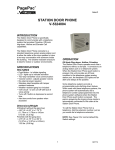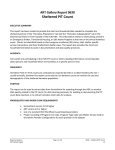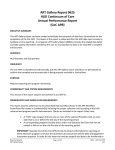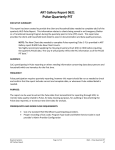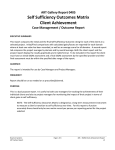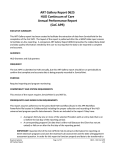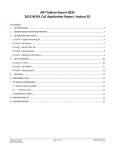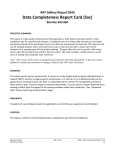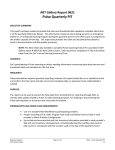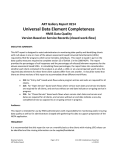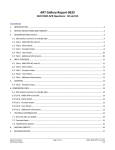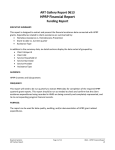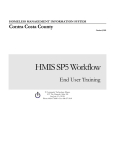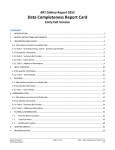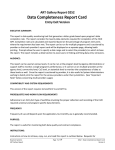Download Client Transition Outcomes - v1 USER MANUAL - MSCCOC
Transcript
ART Gallery Report 0556 Client Transition Outcomes Outcomes and Analytics Contents 1. INTRODUCTION ..................................................................................................................................................3 2. REPORT INSTRUCTIONS AND PROMPTS.............................................................................................................3 3. DESCRIPTION AND LAYOUT ................................................................................................................................6 3.1. Information Common to Multiple Tabs......................................................................................................6 3.1.B-K—Gender, Family, Race, Age and Veteran .............................................................................................6 3.1.G/I—Service Type and Income Sources .......................................................................................................8 3.1.H/J/K—Number of Services, Income Sources, and Monthly Income ..........................................................8 3.2 Tab-Specific Information ...............................................................................................................................9 3.2.A—Outcome .................................................................................................................................................9 3.2.B—Gender ....................................................................................................................................................9 3.2.C—Family......................................................................................................................................................9 3.2.D—Race ........................................................................................................................................................9 3.2.E—Age ..........................................................................................................................................................9 3.2.F—Veteran ...................................................................................................................................................9 3.2.G—Service Type ...........................................................................................................................................9 3.2.H—Number Services ................................................................................................................................. 10 3.2.I—Income Source ...................................................................................................................................... 10 3.2.J—Number of Income Sources .................................................................................................................. 10 3.2.K—Monthly Income .................................................................................................................................. 10 3.2.L—Additional Information......................................................................................................................... 10 4. INPUT CONTROLS ............................................................................................................................................ 11 5. ALERTERS ......................................................................................................................................................... 11 6. DIMENSIONS USED: ......................................................................................................................................... 11 6.1. Information Common to All Tabs ............................................................................................................ 11 6.2 Tab-Specific Information ......................................................................................................................... 11 6.2.A—Outcome .............................................................................................................................................. 11 6.2.B—Gender ................................................................................................................................................. 11 6.2.C—Family................................................................................................................................................... 11 6.2.D—Race ..................................................................................................................................................... 11 6.2.E—Age ....................................................................................................................................................... 11 Bowman Systems ART Gallery Report Page 1 of 22 0556—Client Transition Outcomes v1 6.2.F—Veteran ................................................................................................................................................ 11 6.2.G—Service Type ........................................................................................................................................ 11 6.2.H—Number Services ................................................................................................................................. 11 6.2.I—Income Source ...................................................................................................................................... 11 6.2.J—Number of Income Souces ................................................................................................................... 12 6.2.K—Monthly Income .................................................................................................................................. 12 6.2.L—Additional Information......................................................................................................................... 12 7. TECHNICAL INFORMATION.............................................................................................................................. 12 7.1. How Data Are Pulled................................................................................................................................ 12 7.1.A—All EEs .................................................................................................................................................. 12 7.1.B—EE Trans ............................................................................................................................................... 13 7.1.C—Services ................................................................................................................................................ 13 7.1.D—Income ................................................................................................................................................. 13 7.2. Technical Notes ....................................................................................................................................... 13 7.3. Modification Options............................................................................................................................... 13 7.3.A—Creating a Client Detail Table .............................................................................................................. 13 7.3.B—Creating a Family Detail Table ............................................................................................................. 16 8. MAPPING OBJECTS: ......................................................................................................................................... 20 9. REVISION HISTORY: ......................................................................................................................................... 22 Bowman Systems ART Gallery Report Page 2 of 22 0556—Client Transition Outcomes v1 1. INTRODUCTION Where do clients go after they leave? The purpose of this report is to find, after clients start out in a program, program type, or CoC, where they end up. This widely-applicable report uses program entries to show the client transitions from originating programs, program types, or CoC's into any destination programs, program types, or CoCs. Or any combination of those things! You can measure how many clients were successfully housed, how many have entered the CoC, how many go from shelter to permanent housing, how many were permanently housed after a substance abuse treatment program, or shelter to shelter recidivism. You can also see the various structural and demographic characteristics of clients who end up in the destination programs or program types of interest compared with those who do NOT end up in the destination programs or program types of interest. The applications of the 0556 are very broad; among others, this report can be run by case managers to see how their clients fare, for program staff to chart program success and for executive directors to use in funding applications. The implementation level can see movement between entire CoC's, if desired. The report should be run any time data are needed regarding outcomes. If desired, the report date prompts may be used to modify the date range for the current funding cycle. Prerequisites and workflow requirements: this report requires the use of entry-exits for the programs included in the report. Depending on the openness of your implementation, some stakeholders may be limited in their view of the destination data. 2. REPORT INSTRUCTIONS AND PROMPTS The easiest way to start using this report is to navigate to the automapper. This is a folder that has the reports automatically mapped to your site, so that you don’t have to map them yourself. You can navigate to the automapper as shown in Diagram 2.1, below: Bowman Systems ART Gallery Report Page 3 of 22 0556—Client Transition Outcomes v1 Diagram 2.1: Location of Automapped Reports Requests for additional information concerning the report function/design should be directed to Bowman Systems’ Customer Support Specialist (CSS) staff. How to run: Upon opening the report, the User will be prompted (see Diagram 2.2, below) to specify parameters which control the data returned by the report. Once the User has provided these parameters by responding to the user prompts, a green check-mark will appear next to each field to indicate that a selection has been made. The User should then single-click the “Run Query” button to generate the report. Bowman Systems ART Gallery Report Page 4 of 22 0556—Client Transition Outcomes v1 Diagram 2.2: Report Prompts The user prompts contained in this report are: 1. EDA Provider: The user should select the EDA provider to run the report as, or leave it as the default “-Default Provider-” if EDA mode is not desired. 2. Enter Start Date: The user should type in, or select from the calendar, the first day of the reporting period/year. 3. Enter End Date PLUS 1 Day: The user should type in, or select from the calendar, the day immediately following the last day of the reporting period. For example, if the reporting period is July 1 2009 - September 30 2010, then October 1, 2010 should be entered/selected. 4. Select Case Worker Name (Optional): Select the case worker name to include only clients assigned to that case worker in the report. NOTE: This is an optional prompt; leaving the prompt blank will cause the report to ignore this field and pull in all data regardless of caseworker assigned. 5. Select Providers Coming From (Optional): Click the “refresh list” icon and wait for the left window to refresh. Now select the “coming from” providers to include, by highlighting them in the left window and moving them into the right window using the right selection arrow. NOTE: This is an optional prompt; leaving it blank will cause the report to ignore this field and pull in all data regardless of provider. 6. Select Providers CoC Code Coming From (Optional): Select the provider CoC code to pull all providers with that code designated into the report. NOTE: This is an optional prompt; leaving it blank will cause the report to ignore this field and pull in all data regardless of CoC code. 7. Select Program Types Coming From (Optional): Select the program type code to pull all providers with that code designated into the report. NOTE: This is an optional prompt; leaving it Bowman Systems ART Gallery Report Page 5 of 22 0556—Client Transition Outcomes v1 blank will cause the report to ignore this field and pull in all data regardless of program type code. 8. Select Providers Going To (Optional): Click the “refresh list” icon and wait for the left window to refresh. Now select the “going to” providers to include, by highlighting them in the left window and moving them into the right window using the right selection arrow. NOTE: This is an optional prompt; leaving it blank will cause the report to ignore this field and pull in all data regardless of provider. 9. Select Providers CoC Code Going To (Optional): Select the provider CoC code to pull all providers with that code designated into the report. NOTE: This is an optional prompt; leaving it blank will cause the report to ignore this field and pull in all data regardless of CoC code. 10. Select Program Types Going To (Optional): Select the program type code to pull all providers with that code designated into the report. NOTE: This is an optional prompt; leaving it blank will cause the report to ignore this field and pull in all data regardless of program type code. 3. DESCRIPTION AND LAYOUT The report contains 12 tabs (A through L). 3.1. Information Common to Multiple Tabs 3.1.B-K—Gender, Family, Race, Age and Veteran These tabs are sub-reports, each containing three sections. (See Diagram 3.1.B-K.) Tabs B through K are identical in format, and report data from the perspective of their various defining dimensions (gender, family, race, age, veteran status.) Bowman Systems ART Gallery Report Page 6 of 22 0556—Client Transition Outcomes v1 Diagram 3.1.B-K: Gender, Family, Race, Age and Veteran The first table in the body of the report shows a count of occurrences (Entry/Exits), sorted by the defining dimension. (Examples include gender, household type, race, age, veteran status and income.) • Entry/Exits with null values in the defining dimension are reported as “missing value.” The second table in the body of the report shows total numbers of Entry/Exits in each category of the defining dimension who have and don’t have transitions. • A transition is marked when there is a “going to” Entry after the last “coming from” Entry. • Entry/Exits with null values in the defining dimension are filtered out of the second table on tabs B through F. The third table provides a narrative summary of the information on the first and second tables. • By saving the report as PDF or Excel, the user can copy the narrative into various communication vehicles. Bowman Systems ART Gallery Report Page 7 of 22 0556—Client Transition Outcomes v1 3.1.G/I—Service Type and Income Sources These tabs may have total frequencies higher than the number of occurrences. Diagram 3.1.G: Service Type • • On Tab G, clients may have multiple service types which will be counted in each of the service type categories, so the sum of service types may be higher than the total number of occurrences. (See highlighted totals, above.) On Tab I, clients may have multiple income sources. These will be counted in each of the income source categories, so the sum may be higher than the total number of occurrences. (See highlighted totals, above.) 3.1.H/J/K—Number of Services, Income Sources, and Monthly Income These tabs report on aggregate count of number of services, income sources, or monthly income. Null values are reflected on the reports as zero services, zero income sources, or missing income. (See Diagram 3.1.B-K for example of layout.) • • • Bowman Systems ART Gallery Report Tab H will show the number of service per occurrence. Tab J shows the number of income sources per occurrence. Tab K shows monthly income per occurrence. Page 8 of 22 0556—Client Transition Outcomes v1 3.2 Tab-Specific Information 3.2.A—Outcome Tab A presents a summary of Entry/Exits who have and have not made transitions (see Technical Note 1, page 12) from “coming from” to “going to” providers. • If there is no Exit Date, or if the Exit Date is after the end of the reporting period, the transition is marked as “incomplete.” • If there is an Exit within the reporting period, the transition is marked “complete.” 3.2.B—Gender Tab B shows transition outcomes as related to gender. 3.2.C—Family Tab C shows the transition outcome as related to household makeup (based on group id). • Adults are clients 18 years of age or older as of the reporting period. • Children are clients under 18 years of age. • If the date of birth is null for a client, the report will be unable to determine whether the client is an adult or a child, and will not be able to determine household makeup. Household makeup is determined as follows: Table 3.2.C: Household Makeup, As Determined by Clients in Group ID Household Type Children (under 18) Adults (18 or Older) Single Children One None Child Households Without Adults More Than One None Single Adults Without Children None One Single Adults With Children One or More One Multiple Adults Without Children None More than One Multiple Adults with Children One or More More than One 3.2.D—Race Tab D shows transition outcomes as related to race. 3.2.E—Age Tab E shows transition outcomes as related to age. • Client age at entry is calculated based on date of birth. • Clients who do not have a date of birth recorded, are over 105 years of age, or who have a date of birth after date of program entry, will be reported as possible errors. 3.2.F—Veteran Tab F shows transition outcomes as related to veteran status. 3.2.G—Service Type Tab G shows transition outcomes as related to service types, as described in 3.1.G/I. Bowman Systems ART Gallery Report Page 9 of 22 0556—Client Transition Outcomes v1 3.2.H—Number Services Tab H shows transition outcomes as related to number of different service types received, as described in 3.1.H/J/K. 3.2.I—Income Source Tab I shows transition outcomes as related to income sources, as described in 3.1.G/I. 3.2.J—Number of Income Sources Tab J shows transition outcomes as related to number of income sources, as described in 3.1.H/J/K. 3.2.K—Monthly Income Tab K shows transition outcomes as related to amount of monthly income, as described in 3.1.H/J/K. 3.2.L—Additional Information Tab L is provided as a reference to the user running the report. Figure 3.2.L: Additional Information Parameters specified in the user prompts. (See Section 2 for descriptions of prompts.) An overview, by provider, of number of clients in the report, number of occurrences, and transition status of clients. Bowman Systems ART Gallery Report Page 10 of 22 0556—Client Transition Outcomes v1 4. INPUT CONTROLS This report contains no input controls. 5. ALERTERS This report contains no informational alerters. 6. DIMENSIONS USED: 6.1. Information Common to All Tabs Dimensions Used Entry Exit Uid, Client Uid (from All EEs query), Entry Exit Entry Date, Entry Exit Exit Date (from EE Trans query), Client Unique Id (merge) 6.2 Tab-Specific Information 6.2.A—Outcome This tab only uses the common dimensions shown in 6.1. 6.2.B—Gender Additional Dimensions Client Gender (from EE Trans query) 6.2.C—Family Additional Dimensions Entry Exit Group Id, Client Age at Entry, Client Date of Birth (from EE Trans query) 6.2.D—Race Additional Dimensions Client Primary Race, Client Secondary Race (from EE Trans query) 6.2.E—Age Additional Dimensions Client Age at Entry (from EE Trans query) 6.2.F—Veteran Additional Dimensions U.S. Military Veteran? (from EE Trans query) 6.2.G—Service Type Additional Dimensions Service Code Description (from Services query) 6.2.H—Number Services Additional Dimensions Service Uid (from Services query) 6.2.I—Income Source Additional Dimensions Bowman Systems ART Gallery Report Source of Income (from Income query) Page 11 of 22 0556—Client Transition Outcomes v1 6.2.J—Number of Income Souces Additional Dimensions Source of Income, Recordset ID (from Income query) 6.2.K—Monthly Income Additional Dimensions Last 30 day income (from Income query) 6.2.L—Additional Information Additional Dimensions Entry Exit Provider Id (from EE trans query) 7. TECHNICAL INFORMATION 7.1. How Data Is Pulled 7.1.A—All EEs This is the main query that pulls all the entry exits for active clients with active entry exits. The qualifying entry exits must overlap a specific time frame. There are three optional prompts to pull providers–by providers, by CoC code, or by program type code. These optional prompt are part of an AND clause and when multiple optional prompts are populated, the result set must contain all criteria. Case Worker optional prompt: The report is designed to allow a run for a single case worker. The chart below shows how clients with Entry Exits are included in the report. Diagram 7.1.A—Entry Exits Included in Report Bowman Systems ART Gallery Report Page 12 of 22 0556—Client Transition Outcomes v1 7.1.B—EE Trans This query pulls all of the corresponding Entry/Exit and client demographic information (the “coming from” data, and determines which are the “going to” Entry/Exits (the transitions.) 7.1.C—Services This query pulls the active service information for the “going to” Entry/Exits. 7.1.D—Income This query pulls the active income information for the “going to” Entry/Exits. 7.2. Technical Notes 1. A transition is determined when the maximum “going to” entry is after the minimum “coming from” Entry. 2. The minimum “coming from” is determined from the first Entry for each Client Unique Id among the providers selected in the optional “coming from” prompts: Select Providers Coming From, Select Providers CoC Code Coming From, Select Program Types Coming From. 3. The maximum “going to” is determined from the last Entry for each Client Unique Id among the providers selected in the optional “going to” prompts: Select Providers Going To, Select Providers CoC Code Going To, Select Program Types Going To. 7.3. Modification Options 7.3.A—Creating a Entry/Exit Detail Table 1. Toggle on the formula editor and filter pane. Diagram 7.3.A—Formula Editor and Filter Pane 2. Click on Tab A – Outcome and click on the calculation for the “Transitions to destination program(s)” in the Occurrences column. Bowman Systems ART Gallery Report Page 13 of 22 0556—Client Transition Outcomes v1 Diagram 7.3.A—Formula 3. Make not note of the objects used in the calculation by looking at the formula in the formula editor. =Count([All EEs].[Entry Exit Uid] Where(Not(IsNull([Svs Code (EE)])))) Where([Trans]="T") OBJECT EXPLANATION: The Entry Exit Uid object is used to count each occurrence per Entry/ Exit record. The Svs Code (EE) object is actually an associated dimension for the Client Uid (and displays the Client Uid in tables). The Trans object identifies if the Entry Exit Uid record transitioned to a destination program. 4. Add a new tab by right-clicking one of the tabs at the bottom of the report and select “Insert Report”. Diagram 7.3.A—Insert Report Menu 5. Add a vertical table to the new tab and add the each object listed in the calculation above (#3) in into columns. In this example, Entry Exit Uid is from the All EE Query, and the Svs Code (EE) and Trans objects are from the custom variable folder. Bowman Systems ART Gallery Report Page 14 of 22 0556—Client Transition Outcomes v1 Diagram 7.3.A—Client Table 6. You can click on the “Trans” column and sort to see all of the transitions by either using the Sort icon under “Edit Report” or right-clicking and choosing Sort. Diagram 7.3.A—Sorting 7. You can then add a filter or a column for each of the other counts. Note that the Income and Service objects must be displayed by themselves to prevent #DATASYNC errors from incompatible queries. Common elements (can be used by all tables): [All EEs.Entry Exit Uid], [Svs Code (EE)], [Trans] Table Specific elements (objects that must be separate to avoid DATASYNC issues). Bowman Systems ART Gallery Report Page 15 of 22 0556—Client Transition Outcomes v1 a. HUD Profile Elements: [Adj Gender], [Adj Race], [Adj Vet], [Age Group] Diagram 7.3.A—HUD Elements Table b. Income Elements: [Income Catagories], [Income in EE], [Adj Source] Diagram 7.3.A—Income Elements Table c. Service Elements: [Services].[Service Uid], [Adj Svs Code] Diagram 7.3.A—Service Elements Table 7.3.B—Creating a Family Detail Table 1. Create a new vertical table on a new tab using the [All EEs].[Entry Exit Uid], [Svs Code (EE)], and [Trans] objects. Diagram 7.3.B—Client Detail Table 2. To display family counts based on Entry/Exits, you have to open each of the variables for the family counts. These are located in the Variables folder. Bowman Systems ART Gallery Report Page 16 of 22 0556—Client Transition Outcomes v1 Diagram 7.3.B—Household Variables 3. For example, open [Fam Child Only HH. Copy from the open “(“ after the “Where” to the very last closing parenthesis “)” in the yellow below. Diagram 7.3.B—Children Only Formula 4. Create a blank column in the table. Click on the empty body cell (1) and open your formula editor (2). Diagram 7.3.B—Adding the Formula Bowman Systems ART Gallery Report Page 17 of 22 0556—Client Transition Outcomes v1 5. Paste your formula in and add the following items in pink: =if before the open parenthesis “(“ ;”X” before the LAST closing parenthesis ”)” This will show that particular family count with an “X” =If( (If(IsNull([Entry Exit Group Id]) And [Client Age at Entry]<18;"SC";If(Not(IsNull([Entry Exit Group Id])); If(Count([EE Trans].[Entry Exit Uid]) Where([Client Age at Entry]<18) In([Entry Exit Group Id])>1;"MC"; If(Count([EE Trans].[Entry Exit Uid]) Where([Client Age at Entry]<18) In([Entry Exit Group Id])=1;"SC";"nC"));"nC"))) = "MC" And (If(IsNull([Entry Exit Group Id]) And [Client Age at Entry]>17;"SA";If(Not(IsNull([Entry Exit Group Id])); If(Count([EE Trans].[Entry Exit Uid]) Where([Client Age at Entry]>17) In([Entry Exit Group Id])>1;"MA"; If(Count([EE Trans].[Entry Exit Uid]) Where([Client Age at Entry]>17) In([Entry Exit Group Id])=1;"SA";"nA"));"nA"))) ="nA" And (If(IsNull([Entry Exit Group Id]) And IsNull([Client Date of Birth]);"M";If(Not(IsNull([Entry Exit Group Id])) And IsNull([Client Date of Birth]);"M") In([Entry Exit Group Id]))) <>"M" ;"X") NOTE: To use the above formula copy and paste it into Notepad, then copy it from Notepad and paste it into ART. This will avoid issues involving Word applying special characters to the quotations. 6. The table will display an “X” for any Client record/Entry Exit record that meets the families variable calculation. In the example above, the [Fam Child Only HH] will shows clients whose Entry Exit records indicate there are not adults present and it is either a) group of children or b)a single child. Diagram 7.3.B—Resulting Table NOTE: The original un-modified version of this report is a template and is retained in ART Gallery Templates folder structure. These template folders are read-only and any reports must be copied to a location in the user’s site (Favorites or Public Folders) then mapped to the site’s data. Bowman Systems ART Gallery Report Page 18 of 22 0556—Client Transition Outcomes v1 Bowman Systems ART Gallery Report Page 19 of 22 0556—Client Transition Outcomes v1 8. MAPPING OBJECTS: A listing of the report objects and their source universe and source folder is provided below. Objects are arranged by query and by object type. **Virtual field names for ASSESSMENT objects appear in parenthesis below their corresponding field names QUERY NAME All EE Universe: _u (Client Universe) OBJECT TYPE Result Objects: Filter Objects: FIELD NAME Client Uid Client Unique Id Entry Exit Uid Case Worker Name Case Worker Date Started Case Worker Date Ended Case Worker Uid Entry Exit Exit Date Entry Exit Entry Date Client Inactive Entry Exit Inactive Entry Exit Provider Id Entry Exit provider COC Code Result Objects: EE Trans Universe: ee_u (Entry Exit Universe) Filter Objects: Services Universe: ee_u (Entry Exit Bowman Systems ART Gallery Report Result Objects: Entry Exit Provider Program Type Code Entry Exit Client Uid Entry Exit Uid Entry Exit Group Id Entry Exit Entry Date Entry Exit Exit Date Entry Exit Provider Id Entry Exit Type Client Unique Id Client First Name Client Last Name Client Middle Name Client Date of Birth Client Gender Client Primary Race Client Secondary Race Client Ethnicity Client Ate at Entry U.S. Military Veteran? (VETERAN) Entry Exit inactive Entry Exit Provider COC Code Entry Exit Provider Program Type Code Entry Exit Client Uid Entry Exit Uid Client Unique Id Page 20 of 22 LOCATION Clients folder Clients folder Clients / Entry Exit (Outer) folder Clients / Case Workers folder Clients / Case Workers folder Clients / Case Workers folder Clients / Case Workers folder Clients / Entry Exit (Outer) folder Clients / Entry Exit (Outer) folder Clients folder Clients / Entry Exit (Outer) folder Clients / Entry Exit (Outer) folder Clients / Entry Exit (Outer) /Entry Exit Provider Id folder Clients / Entry Exit (Outer) /Entry Exit Provider Id folder Entry Exit folder Entry Exit folder Entry Exit folder Entry Exit folder Entry Exit folder Entry Exit folder Entry Exit folder Entry Exit / Clients folder Entry Exit / Clients / Client Unique Id folder Entry Exit / Clients / Client Unique Id folder Entry Exit / Clients / Client Unique Id folder Entry Exit / Clients folder Entry Exit / Clients folder Entry Exit / Clients folder Entry Exit / Clients folder Entry Exit / Clients folder Entry Exit / Clients folder Entry Objects folder Entry Exit folder Entry Exit / Entry Exit Provider Id folder Entry Exit / Entry Exit Provider Id folder Entry Exit folder Entry Exit folder Entry Exit / Clients folder 0556—Client Transition Outcomes v1 Universe) Filter Objects: Result Objects: Income Universe: ee_u (Entry Exit Universe) Filter Objects: Bowman Systems ART Gallery Report Service Uid Service Code Service Code Description Service Provide Provider Service Provide Start Date Service Provide End Date Entry Exit inactive Entry Exit Provider Id Entry Exit Provider COC Code Entry Exit Provider Program Type Code Entry Exit Entry Date Service Provided Service Inactive Entry Exit Client Uid Entry Exit Uid Client Unique Id Recordset ID Subassessment: (MONTHLYINCOME) Source of Income (SOURCEOFINCOME) Provider Start Date End Date Last 30 Day income (AMOUNTMONTHLYINCOME) Income received from any source in past 30 days? (SVP_ANYSOURCE30DAYINC OME) Entry Exit inactive Entry Exit Provider Id Entry Exit Provider COC Code Entry Exit Provider Program Type Code Entry Exit Entry Date Inactive Subassessment: (MONTHLYINCOME) Page 21 of 22 Entry Exit / Services (Outer) folder Entry Exit / Services (Outer) folder Entry Exit / Services (Outer) folder Entry Exit / Services (Outer) folder Entry Exit / Services (Outer) folder Entry Exit / Services (Outer) folder Entry Exit folder Entry Exit folder Entry Exit / Entry Exit Provider Id folder Entry Exit / Entry Exit Provider Id folder Entry Exit folder Entry Exit / Services (Outer) folder Entry Exit / Services (Outer) folder Entry Exit folder Entry Exit folder Entry Exit / Clients folder Entry Objects / Monthly Income folder Entry Objects / Monthly Income folder Entry Objects / Monthly Income folder Entry Objects / Monthly Income folder Entry Objects / Monthly Income folder Entry Objects / Monthly Income folder Entry Objects folder Entry Exit folder Entry Exit folder Entry Exit / Entry Exit Provider Id folder Entry Exit / Entry Exit Provider Id folder Entry Exit folder Entry Objects / Monthly Income folder 0556—Client Transition Outcomes v1 9. REVISION HISTORY: Version V1 Bowman Systems ART Gallery Report Description of Changes Original version –BETA Page 22 of 22 0556—Client Transition Outcomes v1






















